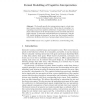Free Online Productivity Tools
i2Speak
i2Symbol
i2OCR
iTex2Img
iWeb2Print
iWeb2Shot
i2Type
iPdf2Split
iPdf2Merge
i2Bopomofo
i2Arabic
i2Style
i2Image
i2PDF
iLatex2Rtf
Sci2ools
DSVIS
2006
Springer
2006
Springer
Formal Modelling of Cognitive Interpretation
We formally specify the interpretation stage in a dual state space human-computer interaction cycle. This is done by extending / reorganising our previous cognitive architecture. In particular, we focus on shape related aspects of the interpretation process associated with device input prompts. A cash-point example illustrates our approach. Using the SAL model checking environment, we show how the extended cognitive architecture facilitates detection of prompt-shape induced human error. Key words: human error, cognitive architecture, model checking, SAL.
Cognitive Architecture | Cognitive Architecture Facilitates | DSVIS 2006 | Human Computer Interaction | Model Checking |
Related Content
| Added | 22 Aug 2010 |
| Updated | 22 Aug 2010 |
| Type | Conference |
| Year | 2006 |
| Where | DSVIS |
| Authors | Rimvydas Ruksenas, Paul Curzon, Jonathan Back, Ann Blandford |
Comments (0)

